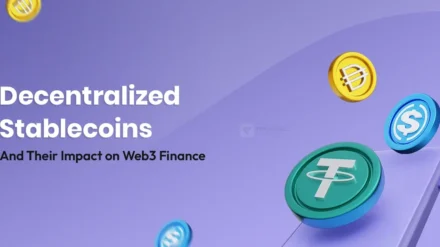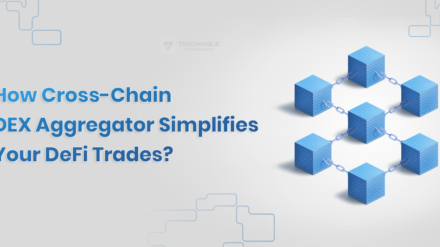Imagine telling your friends, “My cryptos are out there working harder than I am”. They might roll their eyes, and some may laugh. But in DeFi yield farming, this statement is completely true. Your crypto or token assets can work for you, earn rewards, and never get tired or ask for a break.
If you’re a newbie to this space, this guide will help you understand the basics of DeFi yield farming in simple language.
Let’s get started.
A Brief Introduction to DeFi Yield Farming
DeFi yield farming is also known as liquidity mining. It is a strategy employed by crypto users to increase the value of their assets by earning rewards. To get started, users lock their idle tokens to the DeFi trading protocol’s liquidity pools. In return for providing liquidity, the platform rewards them with LP (Liquidity Provider) tokens, representing their level of contribution.
Now, your locked cryptocurrencies or tokens can be used by the platform to provide liquidity that supports its activities. With this liquidity, the platform allows its users to lend, borrow, and trade more effectively. Additionally, AMM (Automated Market Maker) in a crypto trading platform uses your funds to balance buy and sell orders on the platform.
When your assets are traded within the liquidity pool, they earn a certain percentage of interest. And, a partial amount of this will be yours.
Now, you might be thinking, ‘How do I withdraw my funds if all I have are LP tokens?’
Common doubt. To understand this clearly, you need to know how DeFi yield farming actually works. Now, let’s examine each part.
How DeFi Yield Farming Operates?
The platform’s self-executing code, known as “Smart Contracts,” handles the entire decentralized finance yield farming process. It can manage deposits, withdrawals, and LP token distribution automatically for users with no supervision.
Let’s explore how DeFi yield farming operates:
1. Users Deposit Tokens Into Liquidity Pools
Each liquidity pool is created with its own supporting pairs, Eg, USDC/WBTC. First, the user needs to select the pool with which pair they want to contribute.
2. Users Receive Liquidity Provider (LP) Tokens
After depositing your token pairs on the farming pools, the platform issues LP tokens for you. This is like a receipt or proof that carries the value of what you have contributed.
3. The Platform Pays Users With Rewards
This is the point where smart contracts step in. It rewards users with a tiny portion of trading fees, or additional rewards offered by the specific platform (These rewards differ from platform to platform). The rewards will be added to the LP tokens you have.
4. Users Can Use LP Tokens To Farm Even More
Now, LP token carries the value of the token pairs you provided, plus the rewards you earned from farming. Some platforms allow you to farm LP tokens, so you can compound your profits. In this way, your crypto or token works without any breaks to help you generate profits passively.
Now, you know how DeFi yield farming works and where your rewards are stored. Let’s see what you can do with these LP tokens.
Practical Uses of Liquidity Provider Tokens
These LP tokens can be utilized for various use cases that help you generate profits in this decentralized space. Let’s identify what they are:
1. Trade or Withdraw
You can swap LP tokens into decentralized stablecoins or centralized ones. Also, it can be converted into other cryptocurrencies or fiat (if supported) to utilize your earnings.
2. Restaking
You can increase your profits by restaking your LP tokens on restaking platforms. Such as EigenLayer or others.
3. Governance Participation
Users can stake their LP tokens on other protocols or on the same platforms to earn governance tokens. These tokens allow users to vote on important decisions concerning the platform, like changes in platform fees, new feature integration, workflow changes, and more.
4. Use as Collateral
Some platforms let you borrow crypto assets by providing LP tokens as collateral or security. This enables users to access funds without selling their existing portfolio.
5. Maintain For Sustained Gains
If you expect that the future of the platform will grow, then you can hold that token and wait over time until its value gets boosted.
Now that you understand the concept of DeFi yield farming and how you can earn from it. You might see how beneficial it can be for users. However, it also comes with some risks and pitfalls that you should be aware of, which helps you to understand this concept fully. Let’s see what they are:
Key Risks Linked to Decentralized Finance Yield Farming
Here is a list of risks everyone should be aware of before investing funds in a DeFi farm.
1. Smart Contract Problems
We already discussed that yield farming solutions are completely run by the smart contracts. It’s a good thing, but if a developer made a tiny mistake while creating and the hacker takes advantage of that issue, they can drain all the funds from the pools or lock them permanently. So, find a reliable and secure platform for yield farming.
2. Market Fluctuations
Crypto markets can fluctuate faster than our traditional markets, often within minutes or hours. A pool that looks profitable can turn into a loss in a few seconds. So, if your farmed token’s value drops sharply, then you might face a loss.
3. Impermanent Loss
This is one of the trickiest concepts that most beginners find hard to understand. Let’s say you provide two tokens to a liquidity pool. If the value of a single token falls, the pool will automatically modify itself to balance the values of both tokens. In this situation, you might suffer a loss. However, this won’t happen all the time; sometimes you can achieve profits too.
Let’s break down this concept with an easy-to-understand example:
Let’s say you provide:
- 1 BTC (which is worth $1000).
- And, 1000 USDC (a stablecoin that is worth $1 each).
So, you added $2000 total value of assets to the liquidity pool now.
Now, imagine the price of BTC has risen to $2,000.
But, you’re still in the pool, and the pool rebalances your BTC and USDC to maintain a balanced (50/50) value ratio.
This means:
You now have less BTC and more USDC.
If you withdraw now, you could receive 0.7 BTC and 1,400 USDC. But not your original 1 BTC and 1,000 USDC.
So what’s the problem now?
If you simply kept your tokens:
- 1 BTC = $2,000
- 1,000 USDC = $1,000
- Total = $3,000
But in the pool:
- 0.7 BTC = $1,400
- 1,400 USDC = $1,400
- Total = $2,800
So, now you lost $200, even though prices went up.
What you’re experiencing here is impermanent loss.
But remember one thing:
- If BTC’s price goes back to $1,000 before you withdraw, the loss will disappear automatically.
- But if you withdraw while the price is still unbalanced, the loss becomes permanent.
4. Rug Pulls and Scam Risks
There are some scam DeFi yield farming projects in the DeFi space till now. Some developers build yield farming solutions with attractive rewards. Once they get a certain percentage of users and liquidity, they will steal everything and run away. This is why finding a reputable and established one is highly important.
Note: Halborn’s “Top DeFi Hacks of April 2024” report and other security publications highlight that over $77.9 million worth of assets were stolen from a DeFi yield farming solution in 2024.
How Beginners Can Reduce Risk in Crypto Yield Farming
Here, I’ll list out some of the best tips for beginners to help avoid risks in crypto farming.
- As a beginner, start yield farming with some minimal cryptocurrencies that you can afford to lose.
- Search for reliable and established platforms to start crypto yield farming. You can try some platforms like Uniswap, Pancakeswap, and more.
- You can start farming with the stablecoin pools at the beginning stages. This avoids high volatility and lowers the risks for you.
- The strategies and risks of “Yield Farming” may change day by day. So, staying updated helps you make better decisions while farming.
- Finally, try to stake your rewards to experience compounding profits.
At the beginning stages, you need to see yield farming as a learning process rather than a “get rich quick” scheme. This helps you to enjoy the benefits and avoid risks at the start.
Now, let me break down some top yield farming protocols that help you start yield farming securely.
Top Platforms To Start DeFi Yield Farming
Here’s the list of some popular and trusted platforms you can use for crypto yield farming.
1. Uniswap.
2. Aave.
3. Lido Finance.
4. Yearn Finance.
5. Convex Finance.
Great! You have covered the blog completely. It’s time for a wrap. Let’s move forward.
Wrapping Up
The concept of “Yield Farming” provides a beneficial way for crypto users to maximize their assets. Instead of holding your cryptos idle, it helps you passively grow the value of your assets. It acts as a better way for beginners to generate profits in the decentralized space while managing some complicated risks.
However, yield farming doesn’t just benefit crypto users. As more users search for the best platforms to farm their tokens or cryptocurrencies, the demand for reliable platforms continues to grow. This creates a valuable opportunity for entrepreneurs and startups to establish a profitable venture in the DeFi sector.
By hiring a development firm and creating your own yield farming solution, you can step into the DeFi business easily.
Are you planning to create your own solution and are looking for the best DeFi yield farming development company?
Then here is the perfect solution for you. Trioangle, a leading DeFi yield farming development company, creates custom DeFi yield farming solutions by integrating advanced features in the market.
Liked the article? Share this with your friend and say, ‘It’s time we launch our Web3 venture!’





